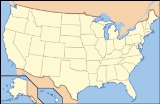
Blood Mountain Wilderness
Encyclopedia
The Blood Mountain Wilderness was designated in 1991 and currently consists of 7800 acres (31.6 km²). The Wilderness is located within the borders of the Chattahoochee National Forest in Lumpkin County
and Union County
, Georgia
. The Wilderness is managed by the United States Forest Service
and is part of the National Wilderness Preservation System
. In November, 1999, three fires burned through parts of the Blood Mountain Wilderness and the Chatahoochee National Forest. Fire crews came from across the nation to help fight the fires.
The highest elevation
in the Blood Mountain Wilderness is the 4458 feet (1,359 m) peak of Blood Mountain
. The Wilderness includes 10.75 miles (17.3 km) of the Appalachian Trail
, which may be the most heavily used portion of the AT
. The Blood Mountain Wilderness is the first wilderness encountered on the AT after its starting point on Springer Mountain
.
In connection with its management of the Wilderness, the Forest Service actively promotes adherence to the Leave No Trace
principles. The seven Leave No Trace principles are:
Lumpkin County, Georgia
Lumpkin County is a county located in the U.S. state of Georgia. As of the 2010 census, the population was 29,966. Its county seat is Dahlonega.- History :...
and Union County
Union County, Georgia
Union County is a county located in the U.S. state of Georgia. As of 2000, the population was 17,289. The 2007 Census Estimate shows a population of 20,968. The county seat is Blairsville.Its Sole commissioner is Lamar Paris, who has served since 2001....
, Georgia
Georgia (U.S. state)
Georgia is a state located in the southeastern United States. It was established in 1732, the last of the original Thirteen Colonies. The state is named after King George II of Great Britain. Georgia was the fourth state to ratify the United States Constitution, on January 2, 1788...
. The Wilderness is managed by the United States Forest Service
United States Forest Service
The United States Forest Service is an agency of the United States Department of Agriculture that administers the nation's 155 national forests and 20 national grasslands, which encompass...
and is part of the National Wilderness Preservation System
National Wilderness Preservation System
The National Wilderness Preservation System of the United States protects federally managed land areas designated for preservation in their natural condition. It was established by the Wilderness Act upon the signature of President Lyndon B. Johnson on September 3, 1964...
. In November, 1999, three fires burned through parts of the Blood Mountain Wilderness and the Chatahoochee National Forest. Fire crews came from across the nation to help fight the fires.
The highest elevation
Elevation
The elevation of a geographic location is its height above a fixed reference point, most commonly a reference geoid, a mathematical model of the Earth's sea level as an equipotential gravitational surface ....
in the Blood Mountain Wilderness is the 4458 feet (1,359 m) peak of Blood Mountain
Blood Mountain
Blood Mountain is the highest peak on the Georgia section of the Appalachian Trail and the sixth-tallest mountain in Georgia, with an elevation of . It is located on the border of Lumpkin County with Union County and is within the boundaries of the Chattahoochee National Forest and the Blood...
. The Wilderness includes 10.75 miles (17.3 km) of the Appalachian Trail
Appalachian Trail
The Appalachian National Scenic Trail, generally known as the Appalachian Trail or simply the AT, is a marked hiking trail in the eastern United States extending between Springer Mountain in Georgia and Mount Katahdin in Maine. It is approximately long...
, which may be the most heavily used portion of the AT
Appalachian Trail
The Appalachian National Scenic Trail, generally known as the Appalachian Trail or simply the AT, is a marked hiking trail in the eastern United States extending between Springer Mountain in Georgia and Mount Katahdin in Maine. It is approximately long...
. The Blood Mountain Wilderness is the first wilderness encountered on the AT after its starting point on Springer Mountain
Springer Mountain
Springer Mountain is located in the Chattahoochee National Forest in Fannin County of northern Georgia. It is now the southern terminus of the Appalachian Trail.-Geography:The mountain's peak is at above mean sea level.-Appalachian Trail:...
.
In connection with its management of the Wilderness, the Forest Service actively promotes adherence to the Leave No Trace
Leave No Trace
Leave No Trace is both a set of principles, and an organization that promotes those principles. The principles are designed to assist outdoor enthusiasts with their decisions about how to reduce their impacts when they hike, camp, picnic, snowshoe, run, bike, hunt, paddle, ride horses, fish, ski or...
principles. The seven Leave No Trace principles are:
- Plan Ahead and Prepare
- Travel and Camp on Durable Surfaces
- Dispose of Waste Properly
- Leave What You Find
- Minimize Campfire Impacts
- Respect Wildlife
- Be Considerate of Other Visitors
External links
- Wilderness.net entry for the Blood Mountain Wilderness
- Blood Mountain Wilderness
- Photos from after the 1999 fire {Please Scroll down after opening}
- Leave No Trace organization

